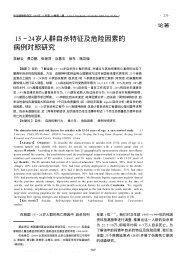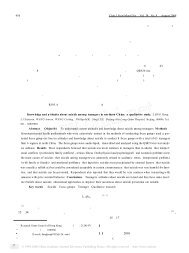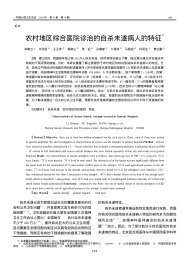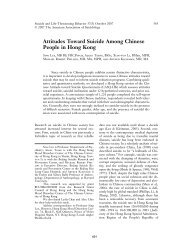Interventions for Suicide Survivors: A Review of the Literature
Interventions for Suicide Survivors: A Review of the Literature
Interventions for Suicide Survivors: A Review of the Literature
Create successful ePaper yourself
Turn your PDF publications into a flip-book with our unique Google optimized e-Paper software.
Jordan and McMenamy 339<br />
surveyed community pr<strong>of</strong>essionals and found and <strong>the</strong> efficacy <strong>of</strong> <strong>the</strong> support received. Such<br />
that while <strong>the</strong>re was a general congruence evidence is critically important to guide <strong>the</strong><br />
between <strong>the</strong> type <strong>of</strong> help <strong>of</strong>fered and received development <strong>of</strong> appropriate and timely inter-<br />
by caregivers and survivors, pr<strong>of</strong>essionals<br />
tended to overestimate <strong>the</strong> percentage <strong>of</strong> survivors<br />
who actually received help from mediventions<br />
<strong>for</strong> at-risk survivors.<br />
cal personnel (doctors, psychiatric nurses, or GENERAL INTERVENTIONS<br />
public health nurses) or from survivor support<br />
groups.<br />
FOR THE BEREAVED<br />
The conflicting findings between <strong>the</strong> Given <strong>the</strong> extensive literature on be-<br />
Provini et al. and Dyregrov studies may perreavement interventions, we have restricted<br />
haps be attributed to differences in <strong>the</strong> orga- our review to meta-analytic studies or large-<br />
nization <strong>of</strong> health care in <strong>the</strong> United States scale reviews <strong>of</strong> <strong>the</strong> literature. On <strong>the</strong> whole,<br />
and Norway, as well as to demographic dif- <strong>the</strong>se studies reveal a surprising and ra<strong>the</strong>r<br />
ferences in <strong>the</strong> two samples. For example, distressing lack <strong>of</strong> effectiveness <strong>for</strong> general<br />
municipalities in Norway are able to provide bereavement interventions. At <strong>the</strong> same time,<br />
more organized postvention services than <strong>the</strong>y also highlight <strong>the</strong> importance <strong>of</strong> identi-<br />
most communities within <strong>the</strong> United States, fying high-risk subgroups <strong>of</strong> bereaved indi-<br />
since Norway has a nationalized health care viduals such as suicide survivors. For a more<br />
system. Given that both samples indicated comprehensive discussion <strong>of</strong> <strong>the</strong> implications<br />
that many <strong>of</strong> <strong>the</strong>ir concerns centered around <strong>of</strong> <strong>the</strong> reviews that follow, please see Jordan<br />
<strong>the</strong> impact <strong>of</strong> suicide on children in <strong>the</strong> fam- and Neimeyer (2003).<br />
ily, <strong>the</strong> relatively younger age <strong>of</strong> <strong>the</strong> Provini Allumbaugh and Hoyt (1999) per<strong>for</strong>med<br />
et al. sample and <strong>the</strong> smaller proportion <strong>of</strong> a meta-analysis <strong>of</strong> 35 bereavement interven-<br />
spousal and child loss may have resulted in tion studies that included ei<strong>the</strong>r a control<br />
fewer people with children, and <strong>the</strong>re<strong>for</strong>e less group or a pre-post treatment design, but not<br />
<strong>of</strong> a perceived need <strong>for</strong> pr<strong>of</strong>essional guidance. necessarily random assignment. Overall, <strong>the</strong>se<br />
Also, <strong>the</strong> mean length <strong>of</strong> time since <strong>the</strong> sui- authors found an effect size across studies <strong>for</strong><br />
cide in <strong>the</strong> Dyregrov study (15 months) was bereavement interventions <strong>of</strong> .43, a finding<br />
much longer than in <strong>the</strong> Provini study (5 that contrasts with <strong>the</strong> typical effect size <strong>of</strong><br />
months). Given that many participants in <strong>the</strong> approximately .80 found in most psycho<strong>the</strong>r-<br />
Dyregrov study indicated that brief, early apy outcome research (Lambert & Bergin,<br />
support was not adequate, <strong>the</strong> Provini et al. 1994; Robinson, Berman, & Neimeyer, 1990).<br />
study may have contacted families too soon, Additional analyses <strong>of</strong> 12 “moderator” vari-<br />
be<strong>for</strong>e <strong>the</strong>y were able to identify specific conables that might account <strong>for</strong> <strong>the</strong> low effect<br />
cerns and long-term needs. size suggested that better results were associ-<br />
Studies have also indicated that many ated with <strong>the</strong> following factors: more highly<br />
more survivors feel a need <strong>for</strong> pr<strong>of</strong>essional trained practitioners (vs. nonpr<strong>of</strong>essional <strong>the</strong>rmental<br />
health services than actually access apists), individual counseling (vs. group treat-<br />
<strong>the</strong>m. Saarinen, Irmeli, Hintikka, Lehtonen, ment), a greater number <strong>of</strong> sessions, and ini-<br />
and Loennqvist (1999) found that while half tiation <strong>of</strong> treatment closer in time to <strong>the</strong><br />
<strong>of</strong> <strong>the</strong>ir sample felt <strong>the</strong> need <strong>for</strong> psychiatric death. A marginally significant trend toward<br />
services, only 25% actually sought <strong>the</strong>m out. a greater effect size was also found <strong>for</strong> clients<br />
Likewise, both Provini et al. and Dyregrov defined as high-risk mourners.<br />
found that only about one in four survivors Using more rigorous selection criteria<br />
actually participated in support groups. Given which included random assignment to treat-<br />
<strong>the</strong> general lack <strong>of</strong> research as well as <strong>the</strong> disment and control groups, similar recruitment<br />
crepant findings in existing needs research, procedures <strong>for</strong> both groups, and initiation <strong>of</strong><br />
additional in<strong>for</strong>mation is needed about adult <strong>the</strong> intervention only after <strong>the</strong> loss had oc-<br />
survivors who receive help, <strong>the</strong> <strong>for</strong>ms it takes, curred, Kato and Mann (1999) provided a

















